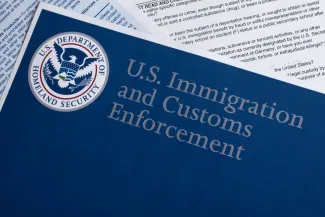
Removals from inside US outnumber border deportations for the first time since 2014
The Trump administration now expects about 600,000 total deportations in 2025, fewer than under the Biden administration’s final fiscal year, as a drop in border crossings outweighs the effect of increased deportations elsewhere, according to a report released Oct. 30 by the Migration Policy Institute, a nonpartisan think tank.
State and local officials are kept in the dark by limited information on deportations, the report noted, whether or not they support the administration’s mass removal agenda.
There were 685,000 total deportations in fiscal year 2024 under Biden compared with the 600,000 projected by the Trump administration for this calendar year, the report states.

© danielfela - iStock-507873830
During the 2025 fiscal year that ended in September, there were about 340,000 deportations, the report estimates, including both orders of removal and people choosing to end detention with voluntary departure. The Trump administration has projected 600,000 deportations for this calendar year, well short of an earlier goal of 1 million.
Unauthorized migration at the border “plunged dramatically” from 2.1 million to 444,000 border encounters in the past fiscal year. Migrants also returned to a former pattern: People crossing the border were mostly single men from Mexico and children from Central America, after a previous surge of border crossers from around the world, the report states.
At the same time, news reports indicate that thousands of migrants who were headed for the U.S. border have reversed course and headed back through the Panamanian jungle to reach South America again.
The lower level of border activity has made it possible for U.S. officials to send border patrol agents to cities such as Los Angeles and Chicago, the Migration Policy Institute report says.
“The steep decrease in unauthorized arrivals at the border and return to nationalities that are easier to turn back because of existing repatriation agreements has permitted the administration to direct its focus to immigration enforcement in the U.S. interior,” the report states.
For the first time since at least 2014, deportations from inside the United States outnumbered apprehensions at the border.
The report noted that the administration has not updated many statistics that would help show trends.
“It has become increasingly complicated to track results because only selective statistics have been made public,” the report stated.
“Returning to regular reporting of detailed data on immigration enforcement across the various Department of Homeland Security (DHS) immigration agencies could not only improve the public’s understanding of current immigration enforcement activities but also inform state and local stakeholders who want to collaborate or who are affected by enforcement,” it said.















